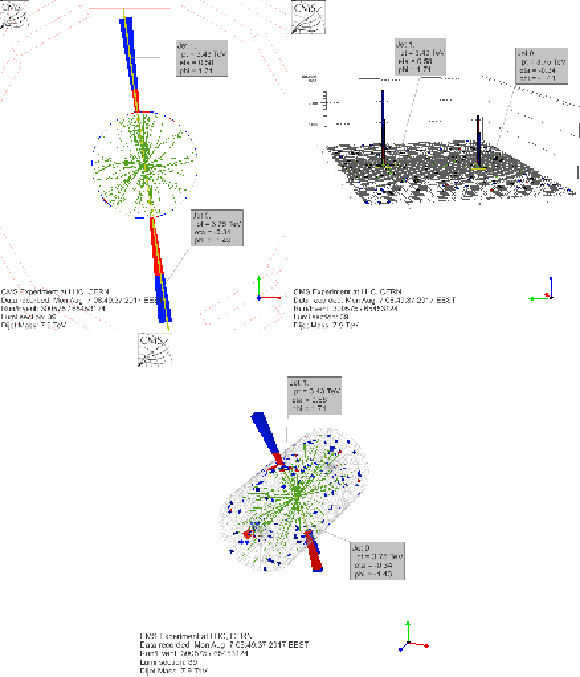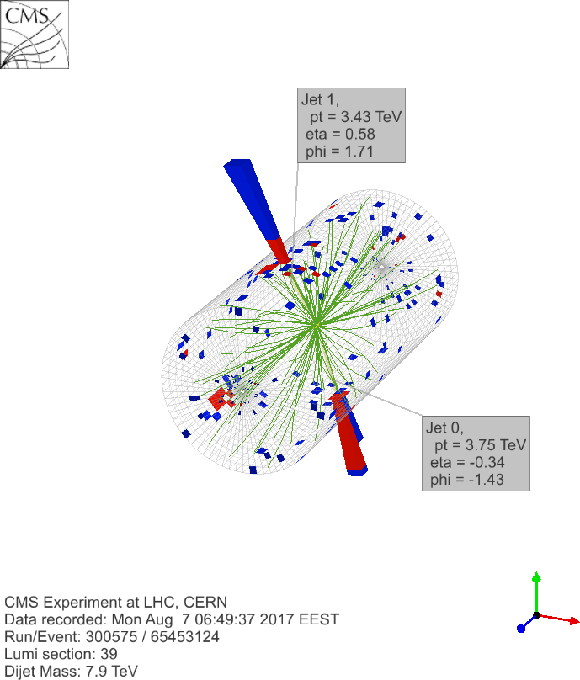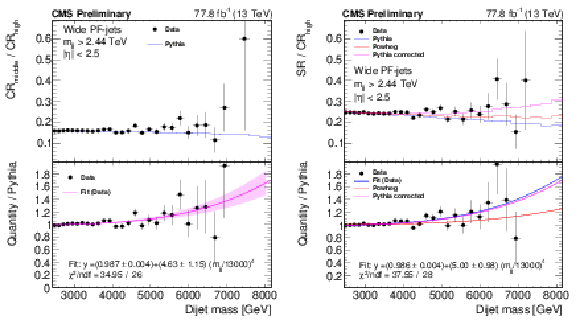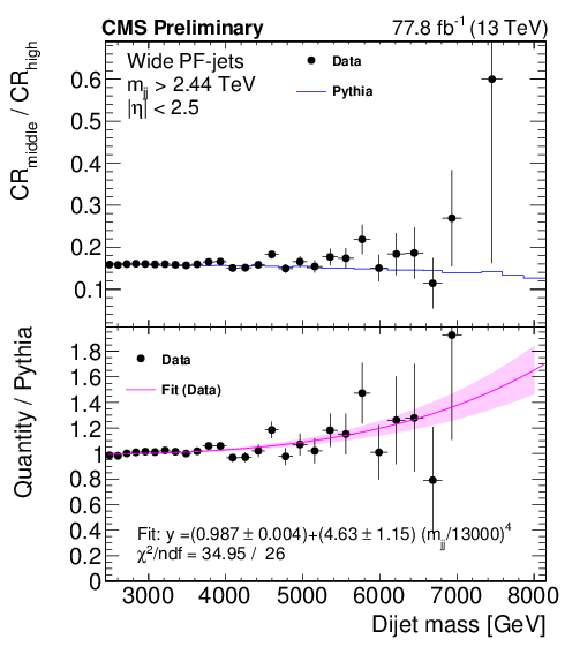

Compact Muon Solenoid
LHC, CERN
| CMS-PAS-EXO-17-026 | ||
| Searches for dijet resonances in pp collisions at $\sqrt{s}= $ 13 TeV using the 2016 and 2017 datasets | ||
| CMS Collaboration | ||
| September 2018 | ||
| Abstract: Searches are presented for resonances decaying to dijet final states in proton-proton collisions at $\sqrt{s}= $ 13 TeV. A high-mass search, for resonances with mass above 1.8 TeV, is performed using dijets reconstructed from data corresponding to an integrated luminosity of 77.8 fb$^{-1}$. The main QCD background is predicted both by fitting the data with an empirical functional form, and with a data-driven method via a $|\Delta\eta|$ sideband. The dijet mass spectrum is well described by both methods and no significant evidence for the production of new particles is observed. Upper limits at 95% confidence level are reported on the production cross section for narrow resonances with masses above 1.8 TeV extending previous searches. Limits are placed on the mass of dijet resonances within various models of new physics. | ||
| Links: CDS record (PDF) ; inSPIRE record ; CADI line (restricted) ; | ||
| Figures & Tables | Summary | Additional Figures | References | CMS Publications |
|---|
| Figures | |

png pdf |
Figure 1:
The pseudorapidity separation between the two wide-jets for the signal and control regions. Data (black points) are compared to QCD predictions from the Pythia-8 MC with detector simulation (red line) normalized to the data. A signal from an RS graviton decaying to two quarks is also shown (blue line) normalized to the same number of events as the data. |

png pdf |
Figure 2:
The dijet mass spectra of the data and Pythia simulation in the SR (black points and red line), $ {\mathrm {CR}_{\mathrm {middle}}} $ (triangles and blue line), and $ {\mathrm {CR}_{\mathrm {high}}} $ (crosses and magenta line). |

png pdf |
Figure 3:
Event displays of the event with the highest dijet invariant mass at 8 TeV. The grouping of the jets into two wide jets is shown in the bottom event display and discussed in the text. |

png |
Figure 3-a:
Event display of the event with the highest dijet invariant mass at 8 TeV. The grouping of the jets into two wide jets is shown in the bottom event display and discussed in the text. |

png |
Figure 3-b:
Event display of the event with the highest dijet invariant mass at 8 TeV. The grouping of the jets into two wide jets is shown in the bottom event display and discussed in the text. |

png |
Figure 3-c:
Event display of the event with the highest dijet invariant mass at 8 TeV. The grouping of the jets into two wide jets is shown in the bottom event display and discussed in the text. |

png pdf |
Figure 4:
Event displays of the event with the second highest dijet invariant mass at 7.9 TeV. |

png |
Figure 4-a:
Event display of the event with the second highest dijet invariant mass at 7.9 TeV. |

png |
Figure 4-b:
Event display of the event with the second highest dijet invariant mass at 7.9 TeV. |

png |
Figure 4-c:
Event display of the event with the second highest dijet invariant mass at 7.9 TeV. |

png pdf |
Figure 5:
Left: $ {R_{\mathrm {ext.}}^{\mathrm {aux.}}} $ auxiliary transfer factor for data (black points) and pythia (blue line) on the top, along with their ratio fitted with the correction function on the bottom (magenta line with 68% CL error band). Right: $ {R_{\mathrm {ext.}}} $ transfer factor for data (black points), Pythia (blue line), Powheg (red line) and corrected Pythia (magenta line) shown on the top. The ratio of data to Pythia (black points) fitted with the correction function (blue line), along with the ratio of Powheg to Pythia (red line), and the ratio of corrected Pythia to uncorrected Pythia (magenta line) are shown on the bottom. The corrected Pythia transfer factor (magenta line) using $ {\mathrm {CR}_{\mathrm {middle}}} $ agrees with the data one (blue line). |

png pdf |
Figure 5-a:
$ {R_{\mathrm {ext.}}^{\mathrm {aux.}}} $ auxiliary transfer factor for data (black points) and pythia (blue line) on the top, along with their ratio fitted with the correction function on the bottom (magenta line with 68% CL error band). |

png pdf |
Figure 5-b:
$ {R_{\mathrm {ext.}}} $ transfer factor for data (black points), Pythia (blue line), Powheg (red line) and corrected Pythia (magenta line) shown on the top. The ratio of data to Pythia (black points) fitted with the correction function (blue line), along with the ratio of Powheg to Pythia (red line), and the ratio of corrected Pythia to uncorrected Pythia (magenta line) are shown on the bottom. The corrected Pythia transfer factor (magenta line) using $ {\mathrm {CR}_{\mathrm {middle}}} $ agrees with the data one (blue line). |

png pdf |
Figure 6:
Dijet mass spectra in the signal region (points) compared to a fitted parameterization of the background (solid curve) and the one obtained from the control region (green squares). For the displayed signal a cross section at the 95% CL observed exclusion limit is being used. The lower panel shows the difference between the data and the fitted parametrization (red), and the data and the prediction obtained from the control region (green), divided by the statistical uncertainty of the data, which for the ratio method includes the one in $ {\mathrm {CR}_{\mathrm {high}}} $ as well. The ratio of the expected signal showed in the upper panel to the statistical uncertainty of the data is also shown for three different resonance masses and signals models. |

png pdf |
Figure 7:
The observed 95% CL upper limits on the product of the cross section, branching fraction, and acceptance for dijet resonances decaying to quark-quark (top left), quark-gluon (top right), gluon-gluon (bottom left), and for RS gravitons (bottom right). The corresponding expected limits (dashed) and their variations at the 1 and 2 standard deviation levels (shaded bands) are also shown. Limits are compared to predicted cross sections for string resonances [18,19], excited quarks [24,25], axigluons [21], colorons [23], scalar diquarks [20], color-octet scalars [26], new gauge bosons W' and Z' with SM-like couplings [27], dark matter mediators for $ {m_{\text {DM}}} =$ 1 GeV [28,29], and RS gravitons [30]. |

png pdf |
Figure 7-a:
The observed 95% CL upper limits on the product of the cross section, branching fraction, and acceptance for dijet resonances decaying to quark-quark. The corresponding expected limits (dashed) and their variations at the 1 and 2 standard deviation levels (shaded bands) are also shown. Limits are compared to predicted cross sections for axigluons [21], colorons [23], scalar diquarks [20], new gauge bosons W' and Z' with SM-like couplings [27], and dark matter mediators for $ {m_{\text {DM}}} =$ 1 GeV [28,29]. |

png pdf |
Figure 7-b:
The observed 95% CL upper limits on the product of the cross section, branching fraction, and acceptance for dijet resonances decaying to quark-gluon. The corresponding expected limits (dashed) and their variations at the 1 and 2 standard deviation levels (shaded bands) are also shown. Limits are compared to predicted cross sections for string resonances [18,19] and excited quarks [24,25]. |

png pdf |
Figure 7-c:
The observed 95% CL upper limits on the product of the cross section, branching fraction, and acceptance for dijet resonances decaying to gluon-gluon.The corresponding expected limits (dashed) and their variations at the 1 and 2 standard deviation levels (shaded bands) are also shown. Limits are compared to predicted cross sections for color-octet scalars [26]. |

png pdf |
Figure 7-d:
The observed 95% CL upper limits on the product of the cross section, branching fraction, and acceptance for RS gravitons. The corresponding expected limits (dashed) and their variations at the 1 and 2 standard deviation levels (shaded bands) are also shown. Limits are compared to predicted cross sections for RS gravitons [30]. |

png pdf |
Figure 8:
The observed 95% CL upper limits on the product of the cross section, branching fraction, and acceptance for quark-quark, quark-gluon, and gluon-gluon type dijet resonances. Limits are compared to predicted cross sections for string resonances [18,19], excited quarks [24,25], axigluons [21], colorons [23], scalar diquarks [20], color-octet scalars [26], new gauge bosons W' and Z' with SM-like couplings [27], dark matter mediators for $ {m_{\text {DM}}} =$ 1 GeV [28,29], and RS gravitons [30]. |

png pdf |
Figure 9:
The 95% CL upper limits on the universal quark coupling $ {g_{\mathrm {q}}} ^{\prime}$ as a function of resonance mass for a leptophobic Z' resonance that only couples to quarks. The observed limits (solid), expected limits (dashed) and their variation at the 1 and 2 standard deviation levels (shaded bands) are shown. Dotted horizontal lines show the coupling strength for which the cross section for dijet production in this model is the same as for a DM mediator. |
| Tables | |

png pdf |
Table 1:
Observed and expected mass limits at 95% CL from this analysis with 77.8 fb$^{-1}$ at $\sqrt {s}=$ 13 TeV compared to previously published limits on narrow resonances from CMS with 36 fb$^{-1}$ at $\sqrt {s}=$ 13 TeV [1] The listed models are excluded between 1.8 TeV and the indicated mass limit by this analysis. The Z' model within the mass interval between 3.1 and 3.3 TeV is also excluded. |
| Summary |
|
Searches for resonances decaying into a pair of jets have been performed using proton-proton collisions at $\sqrt{s}=$ 13 TeV corresponding to an integrated luminosity of up to 77.8 fb$^{-1}$. The dijet mass spectra are observed to be smoothly falling distributions, and the QCD background is predicted using a new method for ${m_{\mathrm{jj}}} > $ 2.4 TeV, utilizing a control region in a $|\Delta \eta|$ sideband. This new background prediction method is orthogonal and complementary to the existing one and with a more robust background prediction. In the analyzed data samples, there is no evidence for resonant particle production. Generic upper limits are presented on the product of the cross section, the branching fraction, and the acceptance for narrow quark-quark, quark-gluon, and gluon-gluon resonances that are applicable to any model of narrow dijet resonance production. String resonances with masses below 7.6 TeV are excluded at 95% confidence level, as are scalar diquarks below 7.3 TeV, axigluons and colorons below 6.2 TeV, excited quarks below 6.0 TeV, color-octet scalars below 3.7 TeV, W' bosons below 3.6 TeV, Z' bosons with SM-like couplings below 2.9 TeV and between 3.1 and 3.3 TeV, Randall-Sundrum gravitons below 2.4 TeV, and dark matter mediators below 2.5 TeV. This extends previously reported limits in the dijet channel. |
| Additional Figures | |

png pdf |
Additional Figure 1:
Ratio of expected 95% CL limits between the fit method and the ratio method when both start from 2.4 TeV (red line) and when the fit method starts at 1.5 TeV and the ratio method at 2.4 TeV (black line). |

png pdf |
Additional Figure 2:
Local significance for a narrow resonance from the fit method (red) and the ratio method search (blue) for $ {\mathrm {q}} {\mathrm {q}} $ resonances. |

png pdf |
Additional Figure 3:
Local significance for a narrow resonance from the fit method (red) and the ratio method search (blue) for $ {\mathrm {q}} {\mathrm {g}} $ resonances. |

png pdf |
Additional Figure 4:
Local significance for a narrow resonance from the fit method (red) and the ratio method search (blue) for $ {\mathrm {g}} {\mathrm {g}} $ resonances. |
| References | ||||
| 1 | CMS Collaboration | Search for narrow and broad dijet resonances in proton-proton collisions at $ \sqrt{s}= $ 13 TeV and constraints on dark matter mediators and other new particles | JHEP 08 (2018) 130 | CMS-EXO-16-056 1806.00843 |
| 2 | ATLAS Collaboration | Search for new phenomena in dijet events using 37 fb$ ^{-1} $ of $ pp $ collision data collected at $ \sqrt{s}= $ 13 TeV with the ATLAS detector | PRD96 (2017) 052004 | 1703.09127 |
| 3 | CMS Collaboration | Search for dijet resonances in proton-proton collisions at $ \sqrt{s} = $ 13 TeV and constraints on dark matter and other models | PLB 769 (2017) 520 | CMS-EXO-16-032 1611.03568 |
| 4 | CMS Collaboration | Search for narrow resonances decaying to dijets in proton-proton collisions at $ \sqrt{s} = $ 13 TeV | PRL 116 (2016) 071801 | CMS-EXO-15-001 1512.01224 |
| 5 | ATLAS Collaboration | Search for new phenomena in dijet mass and angular distributions from pp collisions at $ \sqrt{s}= $ 13 TeV with the ATLAS detector | PLB 754 (2016) 302 | 1512.01530 |
| 6 | CMS Collaboration | Search for narrow resonances in dijet final states at $ \sqrt{s}= $ 8 TeV with the novel CMS technique of data scouting | PRL 117 (2016) 031802 | CMS-EXO-14-005 1604.08907 |
| 7 | CMS Collaboration | Search for resonances and quantum black holes using dijet mass spectra in proton-proton collisions at $ \sqrt{s} = $ 8 TeV | PRD 91 (2015) 052009 | CMS-EXO-12-059 1501.04198 |
| 8 | ATLAS Collaboration | Search for new phenomena in the dijet mass distribution using pp collision data at $ \sqrt{s}= $ 8 TeV with the ATLAS detector | PRD 91 (2015) 052007 | 1407.1376 |
| 9 | CMS Collaboration | Search for narrow resonances using the dijet mass spectrum in pp collisions at $ \sqrt{s} = $ 8 TeV | PRD 87 (2013) 114015 | CMS-EXO-12-016 1302.4794 |
| 10 | CMS Collaboration | Search for narrow resonances and quantum black holes in inclusive and b-tagged dijet mass spectra from pp collisions at $ \sqrt{s}= $ 7 TeV | JHEP 01 (2013) 013 | CMS-EXO-11-094 1210.2387 |
| 11 | ATLAS Collaboration | Search for new physics in the dijet mass distribution using 1 fb$ ^{-1} $ of $ pp $ collision data at $ \sqrt{s} = $ 7 TeV collected by the ATLAS detector | PLB 708 (2012) 37 | 1108.6311 |
| 12 | ATLAS Collaboration | ATLAS search for new phenomena in dijet mass and angular distributions using pp collisions at $ \sqrt{s}= $ 7 TeV | JHEP 01 (2013) 029 | 1210.1718 |
| 13 | CMS Collaboration | Search for resonances in the dijet mass spectrum from 7 TeV pp collisions at CMS | PLB 704 (2011) 123 | CMS-EXO-11-015 1107.4771 |
| 14 | ATLAS Collaboration | Search for new physics in dijet mass and angular distributions in $ pp $ collisions at $ \sqrt{s} = $ 7 TeV measured with the ATLAS detector | New J. Phys. 13 (2011) 053044 | 1103.3864 |
| 15 | CMS Collaboration | Search for Dijet Resonances in 7 TeV pp Collisions at CMS | PRL 105 (2010) 211801 | CMS-EXO-10-010 1010.0203 |
| 16 | ATLAS Collaboration | Search for new particles in two-jet final states in 7 tev proton-proton collisions with the ATLAS detector at the LHC | PRL 105 (2010) 161801 | 1008.2461 |
| 17 | R. M. Harris and K. Kousouris | Searches for dijet resonances at hadron colliders | Int. J. Mod. Phys. A 26 (2011) 5005 | 1110.5302 |
| 18 | L. A. Anchordoqui et al. | Dijet signals for low mass strings at the LHC | PRL 101 (2008) 241803 | 0808.0497 |
| 19 | S. Cullen, M. Perelstein, and M. E. Peskin | TeV strings and collider probes of large extra dimensions | PRD 62 (2000) 055012 | hep-ph/0001166 |
| 20 | J. L. Hewett and T. G. Rizzo | Low-energy phenomenology of superstring-inspired E(6) models | PR 183 (1989) 193 | |
| 21 | P. H. Frampton and S. L. Glashow | Chiral color: An alternative to the standard model | PLB 190 (1987) 157 | |
| 22 | R. S. Chivukula, E. H. Simmons, A. Farzinnia, and J. Ren | Hadron collider production of massive color-octet vector bosons at next-to-leading order | PRD 87 (2013) 094011 | 1303.1120 |
| 23 | E. H. Simmons | Coloron phenomenology | PRD 55 (1997) 1678 | hep-ph/9608269 |
| 24 | U. Baur, I. Hinchliffe, and D. Zeppenfeld | Excited quark production at hadron colliders | Int. J. Mod. Phys. A 02 (1987) 1285 | |
| 25 | U. Baur, M. Spira, and P. M. Zerwas | Excited quark and lepton production at hadron colliders | PRD 42 (1990) 815 | |
| 26 | T. Han, I. Lewis, and Z. Liu | Colored resonant signals at the LHC: largest rate and simplest topology | JHEP 12 (2010) 085 | 1010.4309 |
| 27 | E. Eichten, I. Hinchliffe, K. D. Lane, and C. Quigg | Supercollider physics | Rev. Mod. Phys. 56 (1984) 579 | |
| 28 | A. Boveia et al. | Recommendations on presenting LHC searches for missing transverse energy signals using simplified $ s $-channel models of dark matter | 1603.04156 | |
| 29 | J. Abdallah et al. | Simplified models for dark matter searches at the LHC | Phys. Dark Univ. 9-10 (2015) 8 | 1506.03116 |
| 30 | L. Randall and R. Sundrum | An alternative to compactification | PRL 83 (1999) 4690 | hep-th/9906064 |
| 31 | R. S. Chivukula, E. H. Simmons, and N. Vignaroli | Distinguishing dijet resonances at the LHC | PRD 91 (2015) 055019 | 1412.3094 |
| 32 | CMS Collaboration | The CMS experiment at the CERN LHC | JINST 3 (2008) S08004 | CMS-00-001 |
| 33 | CMS Collaboration | Particle-flow reconstruction and global event description with the cms detector | JINST 12 (2017) P10003 | CMS-PRF-14-001 1706.04965 |
| 34 | M. Cacciari and G. P. Salam | Dispelling the $ N^{3} $ myth for the $ k_\mathrm{t} $ jet-finder | PLB 641 (2006) 57 | hep-ph/0512210 |
| 35 | M. Cacciari, G. P. Salam, and G. Soyez | The anti-$ k_t $ jet clustering algorithm | JHEP 04 (2008) 063 | 0802.1189 |
| 36 | M. Cacciari, G. P. Salam, and G. Soyez | FastJet user manual | EPJC 72 (2012) 1896 | 1111.6097 |
| 37 | M. Cacciari and G. P. Salam | Pileup subtraction using jet areas | PLB 659 (2008) 119 | 0707.1378 |
| 38 | CMS Collaboration | Jet energy scale and resolution in the CMS experiment in pp collisions at 8 TeV | JINST 12 (2017), no. 02, P02014 | CMS-JME-13-004 1607.03663 |
| 39 | CMS Collaboration | The CMS trigger system | JINST 12 (2017), no. 01, P01020 | CMS-TRG-12-001 1609.02366 |
| 40 | CMS Collaboration | Jet algorithms performance in 13 TeV data | CMS-PAS-JME-16-003 | CMS-PAS-JME-16-003 |
| 41 | CMS Collaboration | Searches for dijet resonances in pp collisions at $ \sqrt{s}= $ 13 TeV using data collected in 2016 | ||
| 42 | D. Krohn, J. Thaler, and L.-T. Wang | Jet trimming | JHEP 02 (2010) 084 | |
| 43 | T. Sjostrand, S. Mrenna, and P. Skands | A brief introduction to PYTHIA 8.1 | Comp. Phys. Comm. 178 (2008) 852 | 0710.3820 |
| 44 | CMS Collaboration | Event generator tunes obtained from underlying event and multiparton scattering measurements | EPJC 76 (2016) 155 | CMS-GEN-14-001 1512.00815 |
| 45 | P. Skands, S. Carrazza, and J. Rojo | Tuning PYTHIA 8.1: the Monash 2013 tune | EPJC 74 (2014) 3024 | 1404.5630 |
| 46 | GEANT4 Collaboration | GEANT4 --- a simulation toolkit | NIMA 506 (2003) 250 | |
| 47 | CDF Collaboration | Search for new particles decaying into dijets in proton-antiproton collisions at $ \sqrt{s} = $ 1.96 ~TeV | PRD 79 (2009) 112002 | 0812.4036 |
| 48 | T. Sjostrand, S. Mrenna, and P. Z. Skands | PYTHIA 6.4 physics and manual | JHEP 0605 (2006) 026 | hep-ph/0603175 |
| 49 | CMS Collaboration | CMS luminosity measurements for the 2016 data taking period | CMS-PAS-LUM-17-001 | CMS-PAS-LUM-17-001 |
| 50 | CMS Collaboration | CMS luminosity measurements for the 2017 data-taking period at $ \sqrt{s}= $ 13 tev | CMS-PAS-LUM-17-004 | CMS-PAS-LUM-17-004 |
| 51 | T. Junk | Confidence level computation for combining searches with small statistics | Nucl. Instr. Meth. A 434 (1999) 435 | hep-ex/9902006 |
| 52 | A. L. Read | Presentation of search results: the $ CL_s $ technique | JPG 28 (2002) 2693 | |
| 53 | LHC Higgs Combination Group | Procedure for the LHC Higgs boson search combination in Summer 2011 | CMS-NOTE-2011-005 | |
| 54 | G. Cowan, K. Cranmer, E. Gross, and O. Vitells | Asymptotic formulae for likelihood-based tests of new physics | EPJC 71 (2011) 1554 | 1007.1727 |
| 55 | J. Pumplin et al. | New generation of parton distributions with uncertainties from global QCD analysis | JHEP 07 (2002) 012 | hep-ph/0201195 |
| 56 | V. D. Barger and R. J. N. Phillips | Collider Physics | 1987ISBN 9780201149456 | |
| 57 | B. A. Dobrescu and F. Yu | Coupling-mass mapping of dijet peak searches | PRD 88 (2013) 035021 | 1306.2629 |

|
Compact Muon Solenoid LHC, CERN |

|

|

|

|

|

|